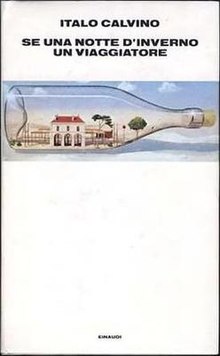If on a winter's night a traveler

|
|
| Author | Italo Calvino |
|---|---|
| Original title | 'Se una notte d'inverno un viaggiatore' |
| Translator | William Weaver (English) |
| Country | Italy |
| Language | Italian |
| Genre | Postmodernist novel |
|
Publication date
|
1979 |
If on a winter's night a traveler (Italian: Se una notte d'inverno un viaggiatore) is a 1979 novel by the Italian writer Italo Calvino. The postmodernist narrative, in the form of a frame story, is about the reader trying to read a book called If on a winter's night a traveler. Each chapter is divided into two sections. The first section of each chapter is in second person, and describes the process the reader goes through to attempt to read the next chapter of the book he is reading. The second half is the first part of a new book that the reader ("you") finds. The second half is always about something different from the previous ones and the ending is never explained. The book was published in an English translation by William Weaver in 1981.
The book begins with a chapter on the art and nature of reading, and is subsequently divided into twenty-two passages. The odd-numbered passages and the final passage are narrated in the second person. That is, they concern events purportedly happening to the novel's reader. (Some contain further discussions about whether the man narrated as "you" is the same as the "you" who is actually reading.) These chapters concern the reader's adventures in reading Italo Calvino's novel, If on a winter's night a traveler. Eventually the reader meets a woman named Ludmilla, who is also addressed in her own chapter, separately, and also in the second person.
Alternating between second-person narrative chapters of this story are the remaining (even) passages, each of which is a first chapter in ten different novels, of widely varying style, genre, and subject-matter. All are broken off, for various reasons explained in the interspersed passages, most of them at some moment of plot climax.
The second-person narrative passages develop into a fairly cohesive novel that puts its two protagonists on the track of an international book-fraud conspiracy, a mischievous translator, a reclusive novelist, a collapsing publishing house, and several repressive governments.
The chapters which are the first chapters of different books all push the narrative chapters along. Themes which are introduced in each of the first chapters will then exist in succeeding narrative chapters, such as after reading the first chapter of a detective novel, then the narrative story takes on a few common detective-style themes. There are also phrases and descriptions which will be eerily similar between the narrative and the new stories.
...
Wikipedia
